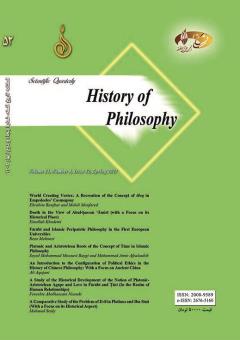Fārābī and Islamic Peripatetic Philosophy in the First European Universities
Subject Areas : . New findings about philosophical figures and schools of Iran and the world of Islam
1 - Associate Professor, Institute of Cultural, Social, and civilization Studies, Tehran, Iran
Keywords: European Universities, Peripatetic philosophy, Latin Averroes, Fārābī, Ibn Sīnā,
Abstract :
Fārābī, the renowned Iranian philosopher, is one of the central figures of Peripatetic philosophy in the world of Islam. The collection of his thoughts travelled beyond Islamic borders to Asian, Europe and Africa posthumously and influenced the scientific fields of Jewish, Christian, and other non-Islamic lands. The thoughts of Fārābī and two other prominent figures of this school of philosophy, Ibn Sīnā and Ibn Rushd, exercised an undeniable impact on the development of the higher scientific centers of Europe of the 13-15 centuries (AD). In fact, without considering their role in the formation of the first European universities, especially the university of Paris and the process of establishing the faculty of philosophy during the conflict between the two faculties of theology and art, one cannot attain a true knowledge of the reasons behind the development and expansion of the first European universities. Relying on valid historical documents and reports, this paper explains this influential process and, at the same time, portrays one of the routes of the transfer of Muslims’ culture and philosophical thoughts to Europe and the quality of the formation of the institution of university during that time.
ايلخاني، محمد (1382) تاريخ فلسفه در قرون وسطی و رنسانس، تهران: سمت.
ورژه، ژاک (1396) دانشگاهها در قرون وسطی، ترجمۀ امیر رضایی، تهران: پژوهشکده مطالعات فرهنگی و اجتماعی.
كانت، ايمانوئل (1400) نزاع دانشكدهها، ترجمۀ رضا ماحوزي، تهران: مؤسسۀ مطالعات فرهنگي و اجتماعي.
مور، جان سی. (1401) تاریخ مختصر دانشگاهها، ترجمۀ هستی عارفی و رضاعلی نوروزی، تهران: مؤسسۀ مطالعات فرهنگی و اجتماعی.
ويتراك، بيورن (1397) سير تكوين دانشگاه مدرن، ترجمۀ آريا متين، تهران: پژوهشكده مطالعات فرهنگي و اجتماعي.
Adamson, P. & Taylor, R. (eds.), (2005). The Cambridge Companion to Arabic philosophy. Cambridge University Press.
Berman, L. V. (1974). Maimonides, the disciple of Alfarabi. Israel Oriental Studise. no. 4, pp. 54-78.
Maimonide, M. & Brague, R. (1996). Traitʼe de logique. Paris: Deselʼee de Brouwer.
Burnett, C. (2001). The coherence of the arabic-latin traslation program in the twelfth Century. Science in Context. no. 14, pp. 249-288.
Burnett, C. (2005). Humanism and orientalism in the translation from Arabic into Latin the Middle Ages. in A. Speer & L. Wegener (eds.), Wissen uebern Gvenzen. Arabisches und lateinisches Mittelalter. Berlin: de Gruytev, pp. 21-24.
Burnett, C. (2013). Revisiting the 155-1550 and 1562 Aristotle- Averroes Edition. In A. Aksoy & G. Giglioni (eds.), Renaissance averroism and its aftermath: Arabic philosophy in early modern Europe, Dordrecht: Springen, pp. 55-64.
Chiesa, B. (1986). Note su al-Farabi, Averroe e Ibn Bagg (Avempace) nella Tradizione ebrica. Henoch. no. 8, pp. 81-84.
Davidson, H. (2005). Moses Maimoides: The Man and His Works. Oxford: Oxford University press.
Efros, I. (1935). Palaqueraʾs Reshit Hokmah and Alfarabiʼs Ihsaʾ al-‘Ulum. The Jewish Quarterly Reviw. no. 25, pp. 227-235.
Fenton, P. (1976). Gleaniugs from Moses Ibn Ezra, Maqalat al-Hediqa. Sefarad. no. 36, pp. 285-298.
Fruedenthal, G. (2002). “Ketav oha-Daʾat or Sefer ha-Sekhel we-ha-Muskalot: The Medieval Hebrew Translation of Al-Farabiʾs “Risalah fil-ʿaql”. A Study in Text History and in the Evolution of Medieval Hebrew Philosophical Terminlogy. The Gewish Quartery Review, vol. 93, no. 1/2, pp. 29-115.
Glassaer, R. (2002). On Gersonides, knowledge of Languages. Aleph. no. 2, pp. 235-257.
Hasse, D. N. & Bertolacci, A. (2012). The Arabic, Hebrew and Latin reception of Avicenna's Metaphysics. De Gruyter press.
Harvey, S. (2002). Falaqueràs Alfarabi, An Example of the Judaization of the Islamic Falasifah. Trumah. no. 12, pp. 97-112.
Hasse, N. (2001). Avicenna on Abstraction. in R. Wisnovsky (ed.), Aspects of Avicenna. Princeton: Markus Wiener. pp. 39-72.
Kreckel, R. (2017). On Academic freedom and elite education in historical perspective: medieval Christian universities and Islamic madarasas. Ottoman place schools, French grandes ecoles and modern world class research universities. SSRN Electronical Journal. Junuary. Martin Luther University Halle-Wittenberg.
Lafleur, C. (1988). Quatre introductions à la philosophia au Xllle siècle. Textes critiques et ètudes historique. Montreal: Institut dʾEtudes Médiévales.
Mahdi, M. (1962). Alfarabiʾs Philosophy of Plato and Aristotle. New York: The Free Press of Glence.
Maimonides, M. (1963). The Guide of the Perplexed. trans. by S. Pines. Chicago: University of Chicago Press.
Marenbon. J. (1987). Later Medieval Philosophy (1150-1350): an introduction. Routledge.
Marx, A. (1935). Text by and About Maimonides. The Jewish Quartery Review, no. 25, pp. 371-428.
McGinnis, J. (2007). Making Abstraction Less Abstract: The logical, Psychological, and Metaphysical Dimensions of Avicenaʼs Theory of Abstraction. In M. Baur (ed.), Intelligence and the Philosophy of Mind, New York: American Catholic Philosophical Asciciation, pp. 163-183.
Perfetti, S. (2000). Aristotleʾs Zoology and its Commentators (1521-1601). Leuven: Leuven University Press, 2000.
Robinson, J. (2009). Samuel Ibn Tibbonʾs Perush ha-Millot ha-Zarot and al-Farabiʼs Eisagoge and Categories. Alep. no. 1, pp. 41-76.
Steinschneider, M. (1893). Die hebraeischen Uebersetzungen des Mittelalter und die Juden als Dolmetscher. Berlin: Komissionverlag des Bibliographischen Bureaus.
Strauss, L. (1936). Eine vermisste Schriff Farabies. Montschrift zur Geschichte und Wissenschoft des Judentum, no. 80, pp. 96-107.
Vajda, G. (1938). Abraham bar Hiyya et al-Farabi. Revue des ètudes juived, no. 104, pp. 113-119.
Zonta, M. (1996). La filodofia antica nel Medioevo ebraico. Brescia: Paideia.
Zonta, M. (1997). Fonti antiche e medievali della logica ebraica nella provenza del Trecento. Medioevo, no. 23, pp. 515-594.

